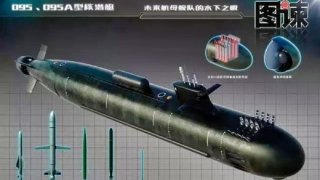China's New Type 095 Nuclear Attack Submarine: Threat to the U.S. Navy?
The Type 095 is expected to have an improved hull design, with a significantly reduced acoustic signature. Relative to the Type 093, the Type 095 will have an improved nuclear reactor, vertical launching system (VLS) cells, and more advanced sensors (including active/passive flank array sonar and low-and high-frequency towed sonar array).
Summary: The article highlights the anticipated Type 095 submarine by China's navy. It emphasizes its advanced features, potential applications in escorting aircraft carriers, and its significance in marking a turning point in China's submarine capabilities. Despite historical setbacks, China is steadily advancing its naval strength, possibly evolving into a formidable blue-water submarine force.
China's Type 095 Nuclear Submarine, explained:
China is working to become a peer of the United States with respect to geopolitical power and influence. And although the US enjoys advantages that China will have a difficult time mitigating (including the world’s most favorable geography and the world’s most robust military budget), China has unrivaled latent economic potential and a revisionist ambition that has alerted American observers. Naturally, the US is beginning to pay closer attention to China’s ability to wage war.
Assessing the Chinese threat
China has the world’s largest population: 1.4 billion people. And while China’s population is aging, reducing its ability to wage war, China still enjoys a unique ability to field a large army, navy, and air force. China, to augment the abilities of their profound human capital, is investing in the development of cutting edge military technologies.
Examples include the recently developed J-20 Mighty Dragon, a fifth-generation fighter that many believe incorporates American technology attained through industrial espionage; the H-20 stealth bomber, which is in the early stages of development; the Fujian aircraft carrier, equipped with a magnetic catapult system comparable to the US’s Ford-class carrier; hypersonic missiles, which the US currently does not possess (and would have a difficult time defending against); and a planned third-generation nuclear attack submarine: the Type 095.
The Type 095 program will complement the ongoing Chinese shipbuilding spree – which has been one of the largest shipbuilding efforts in human history.
Presently, the US still maintains a naval edge over China, respecting fleet quality – but the Chinese have recently surpassed the US with respect to quantity, raising the hackles of the Indo-Pacific region in the process.
The Type 095 is of particular concern to observers – understandably, given that the submarine is a mysterious and fear-inspiring machine, something like the military equivalent of a shark, lurking beneath the ocean's surface. And considering that submarines can deliver nuclear ordnance, submarine-related anxiety is well warranted.
China’s Submarine Fleet
Today, China’s People’s Liberation Army Navy Submarine Force (PLANSF) operates a fleet of 56 submarines.
China “possesses both a nuclear-powered submarine fleet and a robust diesel-electric submarine fleet,” the Nuclear Threat Initiative explains. “While the PLAN is currently developing its nuclear-powered submarine capabilities, its diesel-electric submarine fleet remains the backbone of China’s submarine forces. While its growth is declining, the United States government reports indicate the fleet could grow to between 65 and 70 submarines by 2020s.”
The most pressing contemporary concerns are the Type 094 Jin-class ballistic missile submarine and the Type 093 Shang-class submarine. China operates six Type 094s, which is consider China’s first sea-based nuclear deterrent, boasting 12 JL-3 SLBMs with a 6,200 mile range. The Type 093, meanwhile, represented a significant advancement in China’s underwater sub warfare capability, with six 533mm torpedo tubes that can launch either anti-submarine or anti-ship torpedoes.
But despite the adequacy of the Type 094 and Type 093, the most pressing concern of tomorrow, for China’s adversaries, will be the Type 095.
Future of the PLANSF: The Type 095
The Type 095 is expected to have an improved hull design, with a significantly reduced acoustic signature. Relative to the Type 093, the Type 095 will have an improved nuclear reactor, vertical launching system (VLS) cells, and more advanced sensors (including active/passive flank array sonar and low-and high-frequency towed sonar array).
Reports indicate that the Bohai Shipbuilding Heavy Industrial Corporation will be building the Type 095 at a new plant in Huludao of the Liaoning province. The program is shrouded in secrecy, but expectations are that the Type 095 will be used to escort Chinese aircraft carrier task forces.
Here’s what else is speculated about the Type 095 program: “one commentator found it likely that the Type 095 would have electronic noise-cancellation technology, like your noise canceling headphones, a shaftless drive, and a single hull,” Caleb Larson reported. “All of these would be a huge step forward for China’s submarine program.”
Indeed, the Type 095 indicates that the Chinese could be turning a significant corner with respect to submarine technology. “For many years, China was the subject of ridicule in naval circles,” Larson wrote. “The Korean War put the brakes on Chinese naval innovations, and the Cultural Revolution also hindered naval advancement.” Yet, “despite these setbacks, China has steadily developed its naval capabilities.”
And while China was initially focused on near-shore capabilities, “like smaller diesel submarines, shore-based missile defense, or fast littoral boats, China is now possibly capable of fielding a true blue-water submarine force.”
About the Author: Harrison Kass
Harrison Kass is a defense and national security writer with over 1,000 total pieces on issues involving global affairs. An attorney, pilot, guitarist, and minor pro hockey player, Harrison joined the US Air Force as a Pilot Trainee but was medically discharged. Harrison holds a BA from Lake Forest College, a JD from the University of Oregon, and an MA from New York University. Harrison listens to Dokken. Email the Author: [email protected].


